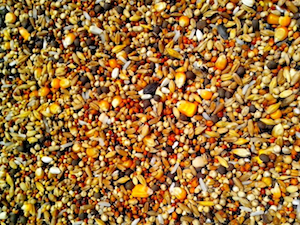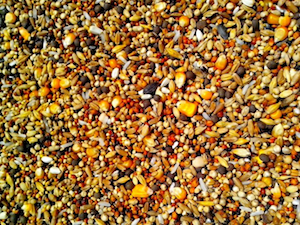
There are several grain staples that can be stored for long periods of time when packaged properly. These are the perfect standby for emergency situations and contain all essential food groups as well as many elements, minerals and vitamins. Get them from local health food stores or buy online. Don’t forget, you’ll need a grinding mill to turn your grains into flour and you’ll need to keep all grains and flours very dry. Weevils can get in and spoil grains so make sure all containers are clean and well sealed.
Good grains to store are:
Wheat is high in gluten (helps bread rise) and is packed with protein, vitamins and minerals. Hard winter wheat, usually white, is best for bread making; soft summer wheat, usually red, is best for pastries and pasta. Wheat flour can be mixed with lower gluten flours to help bread rise.
Buckwheat (actually a fruit, not a grain) can be mixed with wheat flour to provide the eight essential amino acids that can’t be manufactured in the body (tryptophan, lysine, methionine, phenylalaine, threonine, valine, leucine & isoleucine), plus vitamins, minerals, iron, zinc, and linoleic acid. Alone, it makes delicious pancakes, and can be mixed with wheat flour for muffins and breads.
Rye is high in fiber, vitamin E, riboflavin and lysine, eliminating the need for combining with other grains to form a whole protein. It is low in gluten so mix with wheat flour to produce a dark, dense bread. Useful as a filler in sauces, soups, and sausage.
Triticale is a hybrid between rye and wheat with a higher protein but lower gluten content than its parents. It tastes like wheat but should be mixed with wheat flour when high gluten is needed.
Barley contains more fiber, vitamins and lysine than wheat. It can be bought in hulled (hull removed) or pearl (polished) form. While pearl barley cooks faster, the hulled variety retains much more nutrition.
Oats must also be purchased with its hull removed. High in fiber, vitamins and proteins, oats are also higher in calories than wheat. The best oats to store are oat groats, steel cut, or rolled. These can be ground into flour and made into bread (best combined with wheat), cooked as breakfast cereals, or used as fillers in soups, casseroles, or meatloaf. And oatmeal makes great cookies!
Yellow corn, although low in amino acids, contains B vitamins, iron, zinc, magnesium and linoleic acid. Grinding it yourself is most nutritious, since store-bought meal has had the outer skin removed, and with it, fiber and vitamins. It can be stored in its “flint” strain for meal or grits, and the “dent” type for tortillas.
Brown rice is far more nutritious than white because its outer layers, which contain B vitamins, fiber, iron, zinc, and many other vitamins, has not been polished off. Its short shelf life, however, dictates that it must be stored frozen or oxygen-depleted (see below). Converted rice goes through a process of steaming before hulling, which drives more minerals into the rice than regular white. Although it stores more easily, it is more expensive than other rice.
Proper grain storage- oxygen absorbers
Oxygen, along with moisture, can cause spoilage in many foodstuffs. Oxygen absorbers are a non-toxic chemical compound which, when placed in a properly sealed package, reduce the inner oxygen level considerably. Reducing it increases shelf life by inhibiting oxidation (deterioration) of vitamins, spices, fats and oils, and prevents mold growth. They are good for both long and short-term (sending cookies, etc.) packaging needs. Absorbers are labeled by how many cubic centimeters (cc’s) of oxygen they will absorb (400cc, 500cc, etc.). They can be found online at sites such as waltonfeed.com, sorbentsystems.com, or by calling packaging companies in your local yellow pages. Storage in Mylar bags is popular. These are oxygen barrier bags coated with Mylar®, hence the name.
Dry grains, legumes, powders, etc. have low water activity (WA) levels, and require absorbers that activate rapidly (sometimes known as ‘D’ absorbers), a few minutes after being opened.
Do the math!
First you must determine the volume of air your container will hold (when empty) in ccs:
#10 can = 3,950 cc
1 gallon plastic pail/ Mylar® bag = 3,788.4 cc
5 gallon plastic pail/ Mylar® bag = 18,942 cc
6 gallon plastic pail/ Mylar® bag = 22,730.4 cc
Industry standard states that when your container is full of what you packaged (grains, beans, legumes) there will be 38% of air-filled space remaining (in the very top and between the grains) in the container. For example, if you filled a #10 can with beans, all but 38% of the can’s volume would be taken up. So 1,501 cc of air would be left (3,950cc x .38 = 1,501 cc). But air is not what you want to absorb – the oxygen in the air is. Since oxygen makes up only 21.5% of the total volume of air, you must find 21.5% of 1,501 cc, or (1,501 x .215), which comes to approximately 323 ccs of oxygen. Therefore, a 400cc oxygen absorber would be more than enough to protect your #10 canned goods.
For emergencies, bury juice bottles full of dry corn and salt, sealed with roofing cement to keep out critters. Just remember where you buried them — although it’s not fine dining, it’ll keep you from starving.
